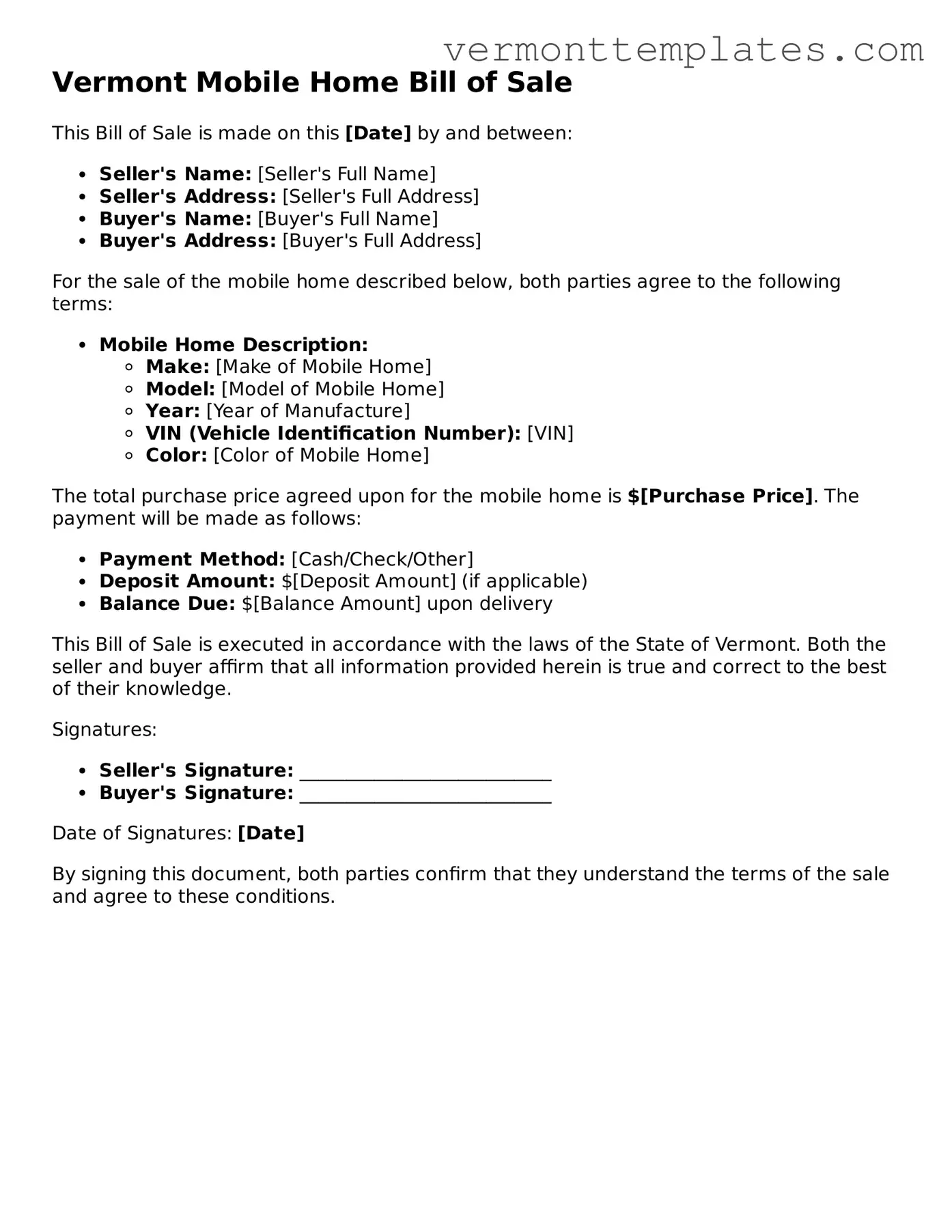The Vermont Mobile Home Bill of Sale form shares similarities with the standard Vehicle Bill of Sale. Both documents serve as proof of transfer of ownership for a mobile home or vehicle. They typically include details such as the seller's and buyer's names, addresses, and signatures. Additionally, both forms require a description of the item being sold, including its identification number, which helps to establish a clear record of the transaction. This ensures that both parties have a reliable reference for future ownership verification.
Another document that resembles the Vermont Mobile Home Bill of Sale is the Boat Bill of Sale. Like the mobile home version, this form is used to document the sale of a boat. It includes essential information about the buyer, seller, and the boat itself. The purpose of both documents is to provide legal evidence of the transaction and to protect the rights of both parties involved. Each form typically requires signatures from both the buyer and seller to validate the agreement.
The Real Estate Purchase Agreement also bears similarities to the Vermont Mobile Home Bill of Sale. Both documents outline the terms of a sale, including the purchase price and any contingencies. While the Real Estate Purchase Agreement is more comprehensive due to the nature of real property transactions, it still serves the fundamental purpose of documenting a transfer of ownership. Both agreements require the parties' signatures to formalize the transaction.
The Equipment Bill of Sale is another document akin to the Vermont Mobile Home Bill of Sale. This form is utilized when transferring ownership of equipment, such as machinery or tools. Similar to the mobile home bill of sale, it contains information about the buyer and seller, as well as a description of the equipment being sold. Both documents aim to provide a clear record of the transaction, ensuring that both parties understand their rights and obligations.
The Motorcycle Bill of Sale shares characteristics with the Vermont Mobile Home Bill of Sale. Both documents serve to facilitate the transfer of ownership between parties. They include key details such as the names of the buyer and seller, a description of the motorcycle or mobile home, and the sale price. Each form typically requires signatures to confirm the agreement, making it a legally binding document for both parties.
Similarly, the Trailer Bill of Sale is comparable to the Vermont Mobile Home Bill of Sale. Both forms document the sale and transfer of ownership of a trailer or mobile home. They include essential information about the buyer and seller, as well as a detailed description of the trailer or mobile home. The goal of both documents is to provide legal proof of the transaction, protecting the interests of both parties involved.
The Personal Property Bill of Sale is another document that resembles the Vermont Mobile Home Bill of Sale. This form is used for the sale of various personal items, including furniture or electronics. Like the mobile home bill of sale, it includes details about the buyer and seller, a description of the item, and the sale price. Both documents serve to establish a clear record of ownership transfer and protect the rights of both parties.
If you are looking to write a strong endorsement for someone, consider utilizing a comprehensive Recommendation Letter template. This form can greatly assist you in articulating the individual’s strengths and qualifications effectively.
The Lease Agreement for a mobile home lot is similar in purpose to the Vermont Mobile Home Bill of Sale. While the former outlines the terms for renting a space for the mobile home, both documents address ownership and the rights of the parties involved. The Lease Agreement may include details about the mobile home itself, while the Bill of Sale focuses on the sale transaction. Both require signatures to confirm the agreement.
Lastly, the Gift Bill of Sale can also be compared to the Vermont Mobile Home Bill of Sale. Although this document is used when transferring ownership as a gift rather than a sale, it still serves the same purpose of documenting the transfer of ownership. Both forms include the names of the parties involved, a description of the item, and require signatures to validate the transaction. This ensures that both parties acknowledge the transfer and its terms.
